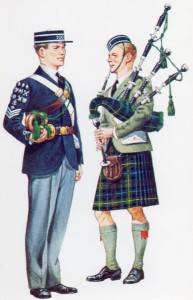
Picture postcard depicting two Boys’ Brigade band members. Date unknown. Image reproduced with kind permission of David Kemp.
Last month’s BBC Scotland documentary – Pipers of the Trenches – highlighted the cultural significance of pipe music during the battles of the First World War in the solidification of Scottish traditions, identity, and heritage within the military. The programme visited descendents of men who carried their pipes in the trenches and explored their stories on the battlefields of Europe, where they were deployed as an inspiration to their comrades.[1] John M. MacKenzie has considered this form of Scottish identity within the realms of the British Empire, asserting that the Scottish soldier was “crucial as an imperial icon” in the formation of Scotland’s own relationship with the Empire.[2] This was especially apparent in Glasgow, with its numerous descendants scattered throughout the Commonwealth, and its status as the second city of Empire with a distinct imperial orientation, making it a significant cultural hub.[3] This article will present the role of the Boys’ Brigade in Glasgow in the promotion of this identity on the rising generation. It will be shown here that this was most prevalent through the music of pipe bands, illustrating the broader cultural significance of this music.
Pipers of the Trenches provided an account of Pipe Major D. Laidlaw, who was one of two pipers presented with the Victoria Cross during the First World War.[4] The other recipient of this decoration was James Richardson, who severed with the Manitoba Regiment of Canada, providing an instance of a Scottish soldier playing his pipes ‘over the top’ as a way to rally his comrades during a time of crisis.[5] Richardson’s youthful musical talents were embraced in his adolescent years as a member of the Boys’ Brigade, where he learnt to play the pipes during his time with the 2nd Rutherglen Company.[6] The years during which Richardson was a member of the Boys’ Brigade in Glasgow was a time when music – and in particular pipe music – came to the fore of Company activities. Pipe bands from the Glasgow Battalion regularly performed in public parks and bands from the city competed in pipe competitions including the prestigious ‘Highland Club Trophy’.[7] This highlights the broader cultural significance of pipe music for the city and the role of youth organisations in the promotion of this cultural tradition.
Annual reports from the Glasgow Battalion illustrate the development of pipe bands and how this type of marching band eventually grew to outnumber those of flute, bugle, and brass in the years preceding the First World War. In the 1904 – 05 session the number of Brigade pipe bands in Glasgow was twenty-three which was seventeen fewer than bugle bands.[8] Bugle bands were considered to be the most suitable for the purposes of the movement and were also the most popular within the organisation as a whole. [9] Therefore, their substantial numbers in the port of Glasgow were consistent with the general picture of the movement. However, by the 1914 – 15 session the number of pipe bands had grown to fifty-one, with bugle bands remaining largely unchanged through the decade at forty-two.[10] This numerical increase illustrates the flourishing nature of pipe bands in Glasgow during the years in which men like Piper Richardson would have been members. This combines to demonstrate the broader cultural connotations of pipe playing in the formation of a national identity at a time when pipe majors were prominent in the creation of the image of the Scottish military.
This article has provided a brief insight into the role of the Boys’ Brigade in Glasgow in the construction of a Scottish identity in this port town. Pipe music was an integral aspect to this, displaying the unique cultural heritage of the nation. The pipers of the First World War provide a striking image of the representation of a Scottish imperial identity. The extent to which pipe playing was undertaken by adolescent boys in Glasgow demonstrates how this type of music was influential at home, with public performances and competitions exhibiting the significance of this branch of company work. Therefore, a Scottish identity of a similar vein as the pipers of the trenches is perceptible in the port of Glasgow through the work of the Boys’ Brigade. As a result of its work, the movement ensured the inheritance and preservation of this musical skill for the following generation.
References
[1] Pipers of the Trenches, BBC Two, 11 July 2014.
[2] John M. MacKenzie, “Irish, Scottish, Welsh and English Worlds? A Four-Nation Approach to the History of the British Empire”, History Compass, 6, no. 5, 2008, 1244 – 1263; 1255.
[3] John M. MacKenzie, “Empire and National Identities: The Case of Scotland”, Transactions of the Royal Historical Society, 8, 1998, 215-231; 224; John M. MacKenzie, “Essay and Reflection: on Scotland and the Empire”, The International History Review, 15, no. 4, 1993, 714-739; 724.
[4] Pipers of the Trenches
[5]Austin Birch, The Story of The Boys’ Brigade, (London: Frederick Muller, 1965 [First published 1959]), 88.
[6]Birch, The Story of The Boys’ Brigade, 88.
[7]J. Berend Shaw, The Glasgow Battalion of The Boys’ Brigade 1883 – 1983, (Edinburgh: Saint Andrew Press, 1983); 14 – 16.
[8] “The Boys’ Brigade. Glasgow Battalion. Twentieth Annual Report”, Glasgow City Archives, 1904 – 05.
[9] John Springhall, Brian Fraser, and Michael Hoare, Sure and Stedfast. A History of the Boys’ Brigade 1883-1983, (London: Collins, 1983); 57; “Old Tales Re-Told”, The Boys’ Brigade Gazette, 23, no. 3, November 1914, 38 – 39; 38.
[10] “The Boys’ Brigade. Glasgow Battalion. Thirtieth Annual Report, “ Glasgow City Archives, 1914 – 15.










Comments are closed.